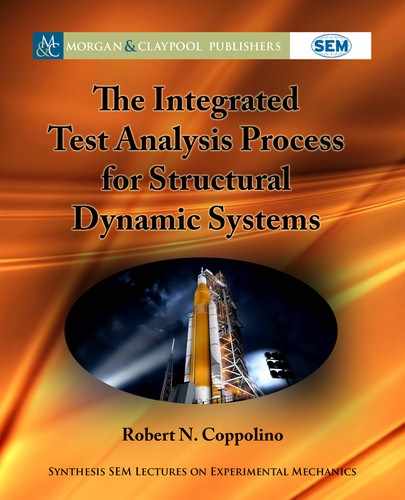
2.2. PART 2: GUIDELINES FOR SYSTEMATIC MODEL DEVELOPMENT 19
Impulsive Force Excitation and Normalized Displacement Response Spectrum
1
0.5
0
2
1
0
-1
-2
0 0.5 1 1.5 2 2.5 3 3.5 4 54.5
t(sec)
0 1 2 3 4 5 6 7 8 9 10
SDOF Natural Frequency (Hz)
F (lb)Response Spectrum
F(t) = sin(2̟t), for 0 ≤ t ≤ 0.5 sec;
F(t) = 0, for t > 0.5 sec.
Figure 2.2: Half-sine pulse and normalized displacement response spectrum.
with relatively high natural frequency. is characteristic also applies to relative displacement
and absolute acceleration shock spectra.
2.2.8 ILLUSTRATIVE EXAMPLE: 1940 EL CENTRO CA GROUND
MOTION DATA
A measured ground motion time history recorded during May 18, 1940 El Centro CA earth-
quake is illustrated in Figure 2.4.
e normalized response spectrum (computed for
n
D 0:02), provided in Figure 2.5, sug-
gests a cut-off frequency, f
D 20 Hz for this particular event.
2.2.9 DEFINITION OF RELEVANT STRUCTURAL DYNAMIC MODELS
In order to develop a relevant dynamic model, general requirements should be addressed based
on:
(1) frequency band, 0 < f < f
, and intensity (F
0
) of anticipated dynamic environments;
and
(2) general characteristics of structural or mechanical components.

20 2. DEFINITION OF TEST ARTICLE FINITE ELEMENT MODELS
Impulsive Force: Normalized Displacement Response Spectrum
10
0
10
-1
10
-1
10
1
10
2
10
0
SDOF Natural Frequency (Hz)
Response Spectrum
Response Spectrum
Low-Frequemcy Asymptote
High-Frequency Asymptote
Quasi-Static Initiation f *
Figure 2.3: Absolute normalized displacement response spectrum.
El Centro Earthquake, May 18, 1940 (NS Data)
0.4
0.3
0.2
0.1
0
-0.1
-0.2
-0.3
-0.4
t(sec)
Accel (g)
0 5 10 15 20 25 30 35 40 45 50
Figure 2.4: El centro NS acceleration time history.
..................Content has been hidden....................
You can't read the all page of ebook, please click here login for view all page.
